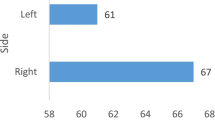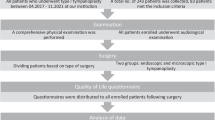Abstract
Purpose
To characterize postoperative pain after tympanoplasty and tympanomastoidectomy and correlate between pain severity and various technical aspects of the surgery.
Methods
We carried out a prospective cohort study of patients undergoing ear surgery in a tertiary referral center between 7/2018 and 7/2019. Patients filled in a pain questionnaire and scored pain intensity on a visual analog scale preoperatively and on postoperative days (POD) 1–4, 21, and 49. The responses were correlated with clinical and operative data, including surgical technique-related details.
Results
Sixty-two patients participated in the study (27 males and 35 females, average age 41.1 ± 20.02 years [range 18–68]). The median preoperative VAS was 5, followed by 6 on POD1, 5 on POD3, and 1 at 3 and 9 weeks. The preoperative questionnaire score normalized to 10 was 4.5 (32/70), 5.1 on POD1, 4.7 on POD3, 0.85 at 3 weeks and 0.85 at 9 weeks. The predictive factors for increased postoperative pain were younger age, the presence of a comorbidity, revision surgery, preoperative dizziness or tinnitus and postoperative tinnitus. The predictive factors for decreased pain were smoking and the addition of a mastoidectomy. None of the factors related to the surgical technique (e.g., surgical approaches, type of reconstruction, specific surgeon) significantly affected the questionnaire responses or the pain VAS intensity scores.
Conclusions
We demonstrated that younger age, the presence of a comorbidity, revision surgery, preoperative dizziness or tinnitus and postoperative tinnitus were predictors of increased pain after tympanoplasty and tympanomastoidectomy, while the inclusion of a mastoidectomy was a predictor of decreased pain.

Similar content being viewed by others
References
Sommer M, Geurts JWJM, Stessel B et al (2009) Prevalence and predictors of postoperative pain after ear, nose, and throat surgery. Arch Otolaryngol Head Neck Surg 135:124–130. https://doi.org/10.1001/archoto.2009.3
Güven M, Kara A, Yilmaz MS et al (2018) Comparison of incidence and severity of chronic postsurgical pain following ear surgery. J CraniofacSurg 29:e552–e555. https://doi.org/10.1097/SCS.0000000000004532
Nemati S, Okhovvat SA, Naghavi SE et al (2014) Relative frequency of chronic postoperative pain in patients operated for chronic otitis media. Eur Arch Oto-Rhino-Laryngology 271:2139–2143. https://doi.org/10.1007/s00405-013-2696-5
Manna S, Kaul VF, Gray ML, Wanna GB (2019) Endoscopic versus microscopic middle ear surgery: a meta-analysis of outcomes following tympanoplasty and stapes surgery. OtolNeurotol 40:983–993. https://doi.org/10.1097/MAO.0000000000002353
Wittekindt D, Wittekindt C, Meissner W, Guntinas-Lichius O (2012) Postoperative pain assessment after middle ear surgery. HNO 60:974–984. https://doi.org/10.1007/s00106-012-2556-4
Jung KH, Cho Y-S, Hong SH et al (2010) Quality-of-life assessment after primary and revision ear surgery using the chronic ear survey. Arch Otolaryngol Head Neck Surg 136:358–365. https://doi.org/10.1001/archoto.2010.24
Nadol JB, Staecker H, Gliklich RE (2000) Outcomes assessment for chronic otitis media: the Chronic Ear Survey. Laryngoscope 110:32–35. https://doi.org/10.1097/00005537-200003002-00009
Martin T, Moualed D, Paul A et al (2015) The Cambridge Otology Quality of Life Questionnaire : an otology- specific patient-recorded outcome measure. A paper describing the instrument design and a report of preliminary reliability and validity. ClinOtolaryngol 40:130–139. https://doi.org/10.1111/coa.12338
Plodpai Y (2018) Endoscopic vs microscopic overlay tympanoplasty for correcting large tympanic membrane perforations: a randomized clinical trial. Otolaryngol Head Neck Surg 159:879–886. https://doi.org/10.1177/0194599818786948
Rai AK, Singh GB, Sahu R et al (2014) Evaluation of simultaneous bilateral same day tympanoplasty type I in chronic suppurative otitis media. Auris Nasus Larynx 41:148–152. https://doi.org/10.1016/j.anl.2013.10.007
Funding
None to declare.
Author information
Authors and Affiliations
Corresponding author
Ethics declarations
Conflict of interest
The authors declare that they have no conflict of interest.
Research involving human participants and/or animals
Study was performed in accordance with the ethical standards, approved by the institutional ethics committee and informed consent was achieved from all subjects.
Additional information
Publisher's Note
Springer Nature remains neutral with regard to jurisdictional claims in published maps and institutional affiliations.
Supplementary Information
Below is the link to the electronic supplementary material.
Rights and permissions
About this article
Cite this article
Carmel Neiderman, N.N., Frisch, M., Handzel, O. et al. Characterization of pain after tympanoplasty and tympanomastoidectomy and analysis of risk factors. A prospective cohort study. Eur Arch Otorhinolaryngol 279, 1765–1775 (2022). https://doi.org/10.1007/s00405-021-06845-y
Received:
Accepted:
Published:
Issue Date:
DOI: https://doi.org/10.1007/s00405-021-06845-y




